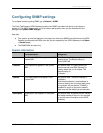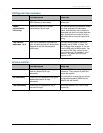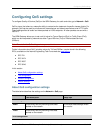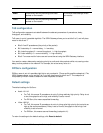
Configuring general ISDN settings
Cisco TelePresence ISDN Gateway 2.1 Online help (Printable format) 74 of 135
or International.
In such cases select this option to
set the TON for outgoing ISDN calls
to National or International as
required.
For International you must also
specify the International prefix
setting.
specified in the International prefix
field. If there is a match the call is
International; otherwise the call is
National.
For example, assume that Specify
national/international type of
number is selected and
International prefix is set to 011. If
a user then calls 01144555333 the
number will have an International
TON and is sent as 44555333 (the
international prefix is stripped from
the outgoing call). If the user had
instead called 11144555333 then the
number would have a National TON
and be sent as 11144555333.
If no value is specified in the
International prefix field, then no
called number will match the
international prefix and all calls will
have a National TON.
International prefix
This field only applies if you
selected Specify
national/international type of
number.
Use this field to specify the dialing
code prefix for international
numbers dialed from your network
(for example, 00 from networks in
Portugal or 011 from the United
States).
For aggregation calls, if one sub-call
has the International prefix present
then all sub-calls must have the
prefix.
E1 CRC-4 enabled
With an ISDN interface type of E1
selected in the Basic settings, this
option selects whether ISDN
signalling should make use of the
CRC-4 mechanism.
Most E1 ISDN networks require
CRC-4 to be enabled, although
some (in particular, some French
networks) require it to be disabled.
Refer to your ISDN network provider
if you are unsure whether to enable
or disable CRC-4.
The ISDN Gateway may have to be
restarted for changes of this setting
to take effect (see
Shutting down the
ISDN Gateway).
T1 ESF enabled
With an ISDN interface type of T1
selected, this option selects
whether ISDN signalling should
make use of the Extended
Superframe Framing technique.
Most T1 ISDN networks require ESF
to be enabled. Refer to your ISDN
network provider if you are unsure
whether to enable or disable ESF.
The ISDN Gateway may have to be
restarted for changes to this setting
to take effect.
Send channel ID in
Q.931
Do not change these settings
unless advised to do so by Cisco
Not all settings apply to all networks.
For example, the National bits are


















